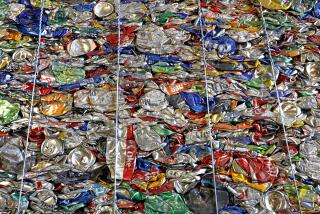Company Says It Has Better Way to ‘Mine’ Cans
- Share via
Like others in the recycling industry, Errol Segal of Los Angeles-based Active Recycling Co. sees non-recycled aluminum cans as a rich vein of ore there for the mining.
And, like others in the industry, he sees the so-called reverse vending machine as a piece of sophisticated mining equipment to tap the 35% to 45% of aluminum cans that aren’t recycled.
However, the machines haven’t lived up to the shiny promises of two years ago, when the California Grocers Assn. launched a program to place thousands of machines at grocery stores and shopping centers. The machines, which should have been ubiquitous by now, have been plagued by chronic equipment problems and zoning restrictions. Segal, who says he spent $250,000 developing his Woodsy Owl model, complains that “we have the most successful failure in the world today.”
Reverse vending machines take aluminum cans and dispense money. The biggest problem, though, according to grocers association President Don Beaver, is that earlier models weren’t that simple. “The machines were doing too many things; they were too complicated,” he says. The Crunch Bird machines promoted by the grocers group eventually were yanked off the market.
Segal says he and partner Warren Braun went through more than a dozen manufacturers before finding a reliable model. The six-foot, brightly painted unit is in field tests at two locations, the Westward Ho store in Sherman Oaks and the 32nd Street Market near USC.
“It is the least complicated machine on the market,” Segal says, claiming that, properly maintained, it’s almost trouble free. “It’s perfect as long as someone who cares is taking care of it,” by refilling the penny dispenser, emptying the machines and wiping off sticky residues.
Unfortunately for Segal, the two field-test models are the only ones on the market. Nine others are collecting dust while Segal tries to convince cautious grocers that equipment failures have been overcome.
For Gary Petersen, president of West Los Angeles-based Aluminum Recycling Corp., the problem hasn’t been balky machines but balky city councils.
Petersen’s firm announced a year ago plans to put 150 Can Banks around Southern California. It’s behind schedule, with only 45 in place.
The Can Banks, which are the size of a small house trailer and have several times the storage capacity of the Woodsy Owl units, fall into a gray area of zoning regulations. Planners are unable to decide whether they’re machines or buildings. Considering that Los Angeles County alone has 80 distinct cities, Petersen says, “you’re talking months” of delay and miles of red tape.
“You can’t blame government,” he says. “This thing is still so new that when I walk into a planning department, they say, ‘Gee, I don’t know how to handle this one, it isn’t something we have on the books.’ But after they look at this thing, planners recognize that it is worthwhile.”
It can be worthwhile for both consumers and recycling companies alike. According to RecyCal, a nonprofit industry group, California consumers turned in 2.5 billion cans in the first half of 1984 and got back $30 million. The going rate for aluminum is about 25 cents a pound, or about a penny a can, at the consumer level; recycling companies turn around and sell the recycled metal to aluminum companies for about 36 cents a pound.
Segal admits that the machines may still be ahead of their time. “We were one of the last to come on the scene,” Segal says. “We have the best machine, but maybe it’s just too early. It’s hard to convince someone that the recycling business is one of the most lucrative around.”
More to Read
Inside the business of entertainment
The Wide Shot brings you news, analysis and insights on everything from streaming wars to production — and what it all means for the future.
You may occasionally receive promotional content from the Los Angeles Times.









